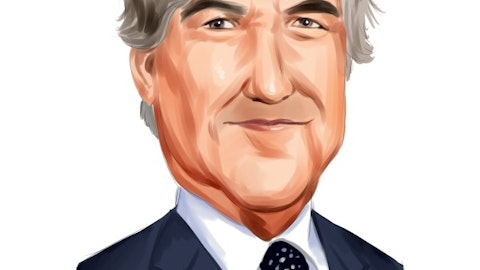Finian O’Shea: Yeah, that makes sense. And just to clarify that that team existed at Sixth Street previously? Or did you — ?
Joshua Easterly: No, most have existed, although we got into it.
Finian O’Shea: Awesome. Thanks so much.
Joshua Easterly: Thanks, Finian.
Operator: Our next question comes from Mark Hughes with Truist Securities. Your line is open.
Mark Hughes: Yeah. Thank you. Good morning. Related to the last question any specific numbers you can share in terms of the percent of the portfolio maybe at or below one times in terms of interest coverage and kind of how you’re modeling that progressing through 2024, if we do stay higher for longer?
Joshua Easterly: Yeah. So look outside of the — the math quickly outside the nonaccrual name it’s about 5% the non-accrual name of American achievement. And although, I would say two of those are really good businesses there to just continue to make investment and have a ton of liquidity. So it’s still at a reasonably low level. And again, I think companies are really focused on capital allocation and solving for cash flow. So, I don’t know, if that’s the peak number, but it’s surely companies are very much focused on it. The other thing, I would say is interest coverage across the portfolio. So we just talked about the tail. But across the portfolio is about two times. And so it ended up down slightly. And I think that’s LQA annualized. And obviously, we’re kind of peakish rates. And I think that was basically flat down 0.1% quarter-over-quarter.
Mark Hughes: Appreciate that. And then Bo, you mentioned only 3% upsize this quarter. Was that — is that reflective of maybe pressure on the companies that they are not in a position to raise more capital? Or is that just some normal variation perhaps? .
Bo Stanley: Yeah, I think it’s really more driven by skill or a rather anemic M&A market. So when we see a lot of upside as the portfolio companies it’s generally M&A related or it can be an investment related. As Josh just mentioned, I think companies have been focused on capital allocation, they are investing heavily prior when interest rates were lower cost of capital is lower now folks just in terms of people investment, in terms of the capital investments are really focused on areas that drive high ROIC. So you’re seeing less of that and more focus on getting super efficient driving more cash flows. But the big driver for this would be M&A.
Mark Hughes: Understood. Thank you.
Operator: One moment for our next question. Our next question comes from Robert Dodd with Raymond James. Your line is open.
Robert Dodd: Hi, guys. Good morning. So going back to one of your comments Josh on Tim’s question. I mean, when you look at what’s going to be the differentiator for private credit businesses and obviously, low term you normally bought out to credit. Your comment being that the sponsors are stepping up. The economy is only really weakening at the margin. So what kind of time frame do you think the credit differentiation between portfolios, between managers, between shareholder returns? What kind of time frame do you think that’s going to manifest on?
Joshua Easterly: Yes. Thanks. I think — let me repeat the question back understood it, which was, if there’s differentiation in shareholder experience based on credit losses when does that start appearing? Is that the question, Robert?
Robert Dodd: Yes.
Joshua Easterly: Okay. So let me start off and say I think — what we should have said if it wasn’t clear is that there will be more differentiation. I think there is — if you look at the data and you know the data both and I do. There has been — even in the benign credit environment of the last — eight to 10 years there’s been significant differentiation already across the space as it relates to investor experience, most of that driven by credit losses. And so, I would say that the differentiation already kind of exists. I think since — if you look at since our IPO, for example, I think ROE for the space have been averaged about 7%, top quartile has been about — first pointing to the top quartile about 9%. We’ve been to 13.3% most of that’s been on the credit line.




